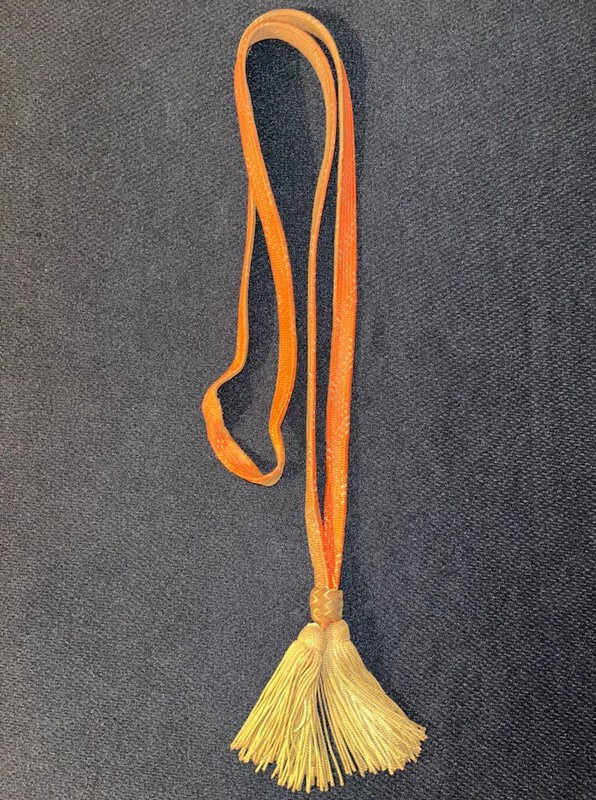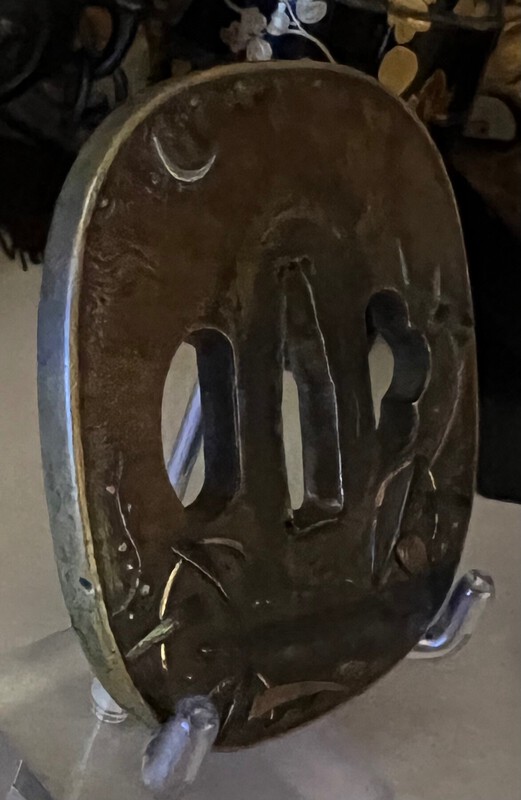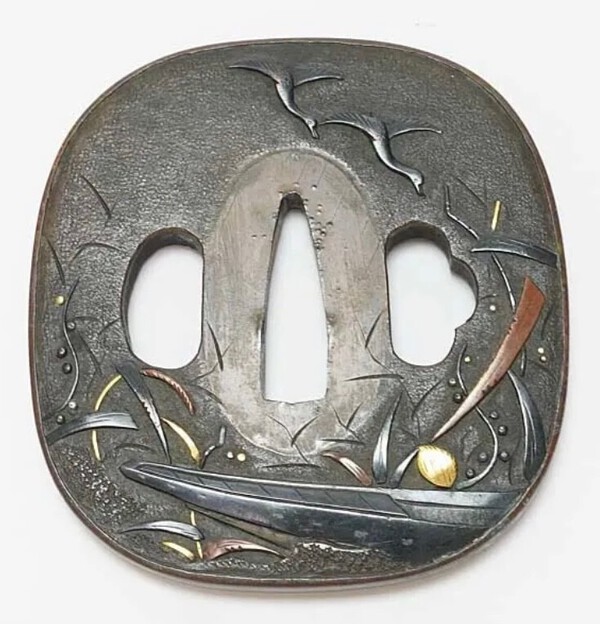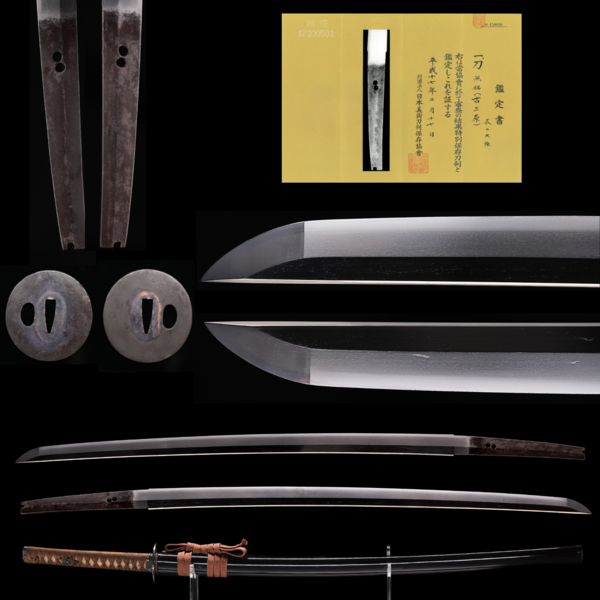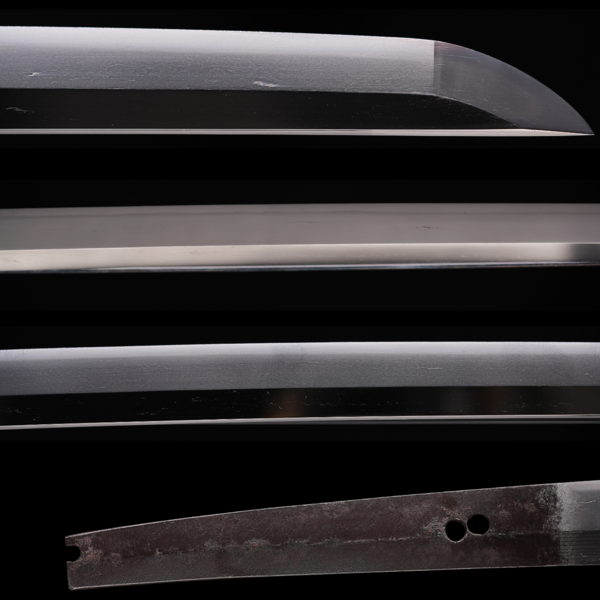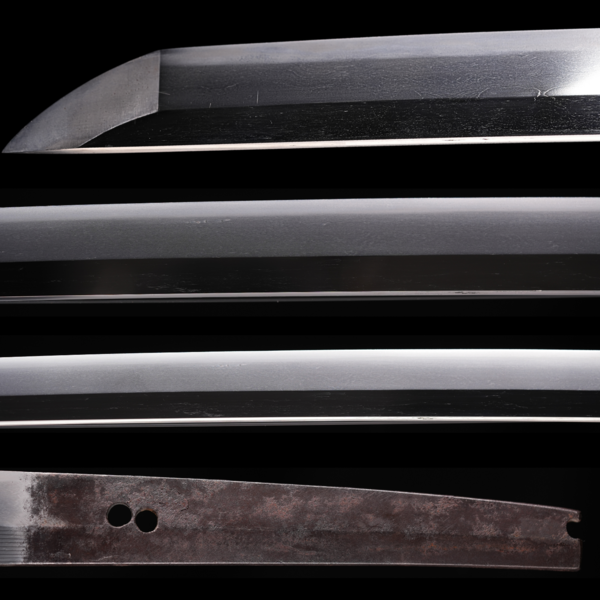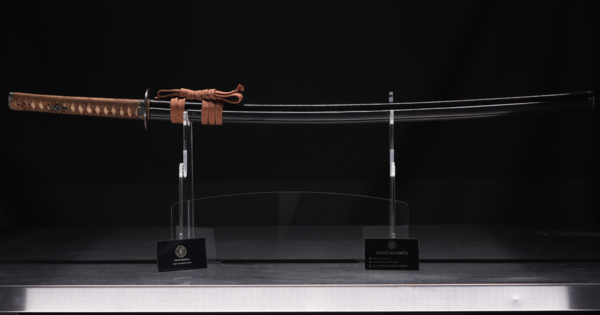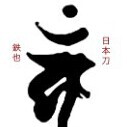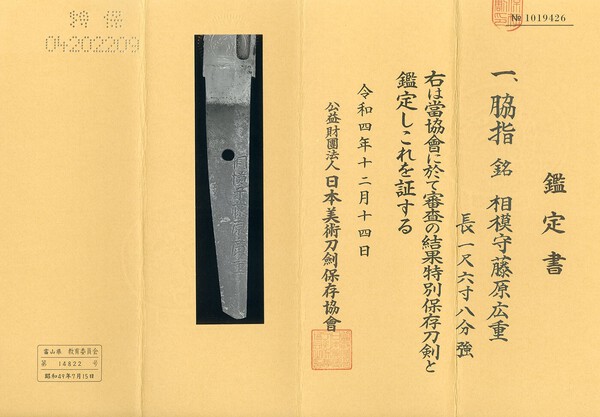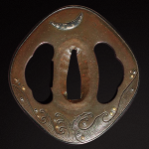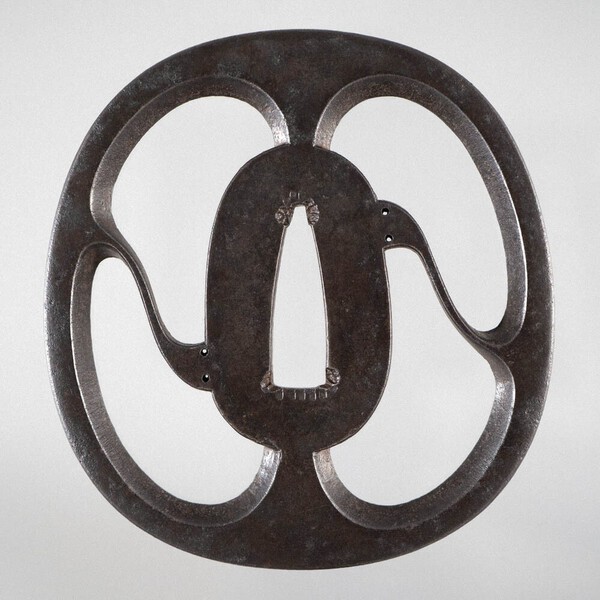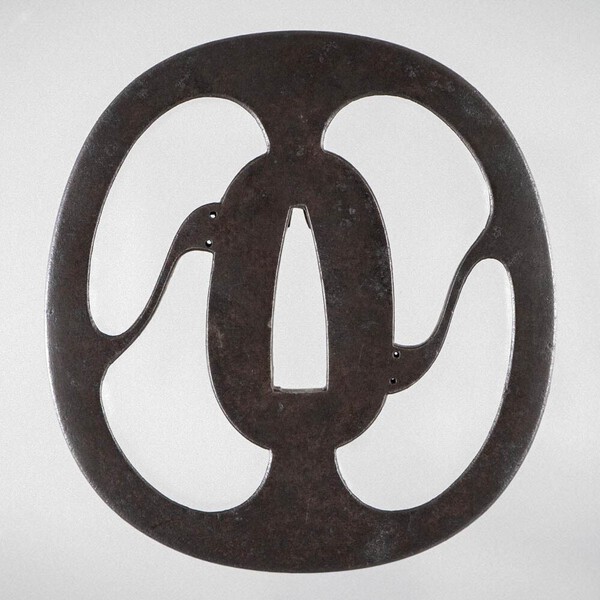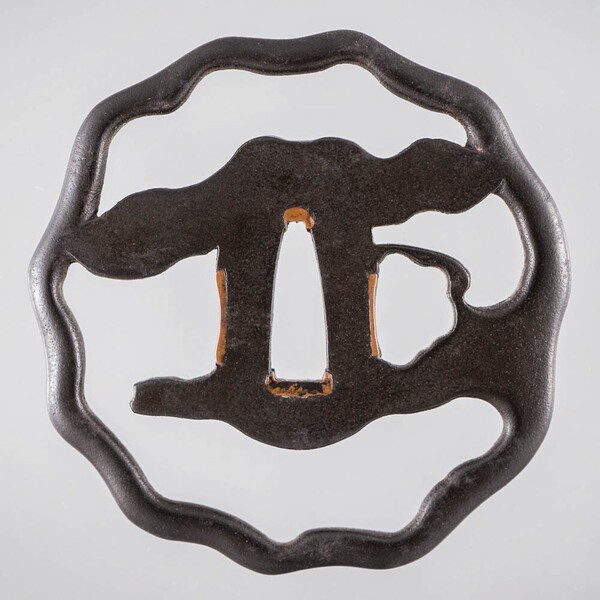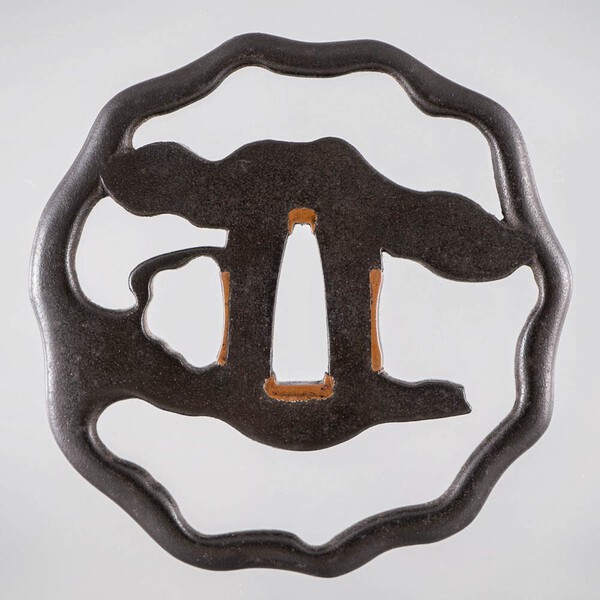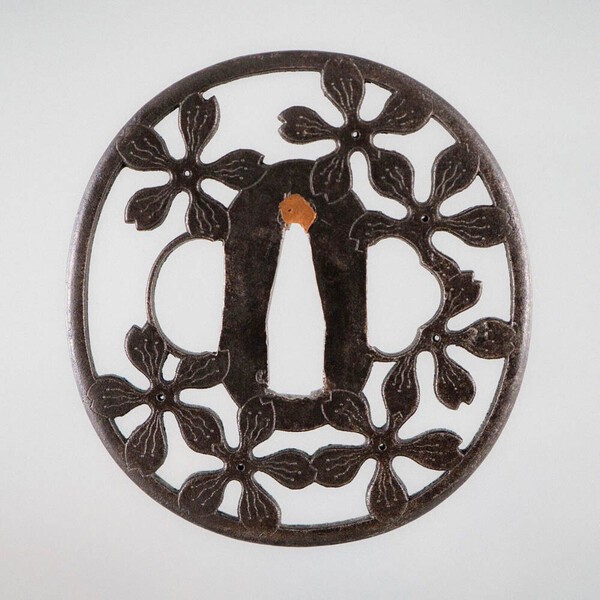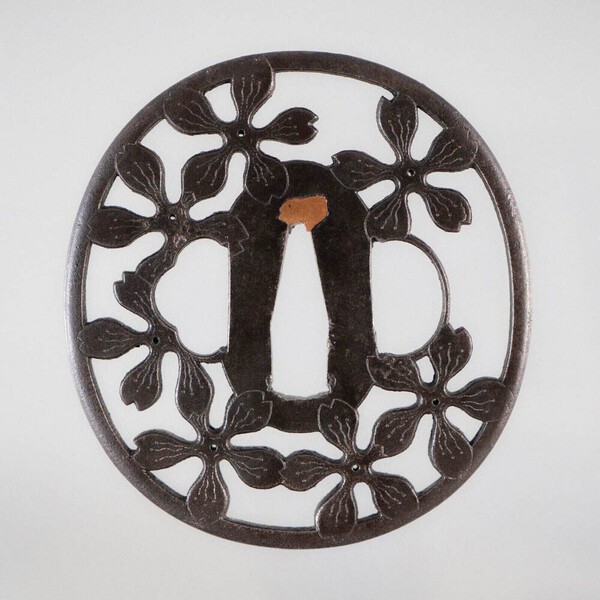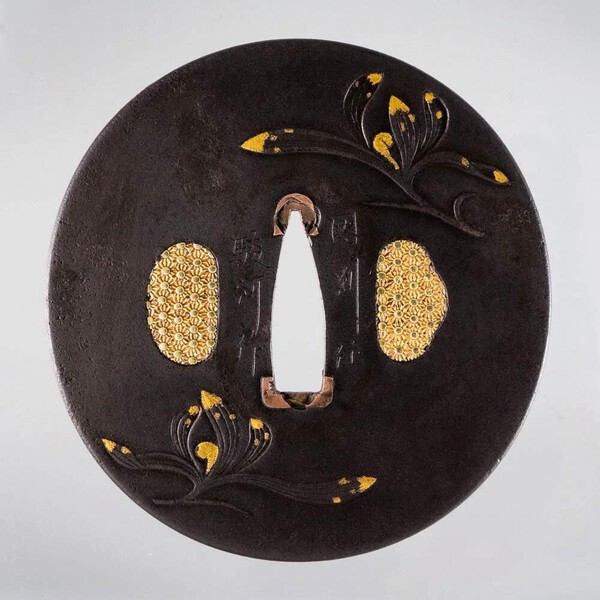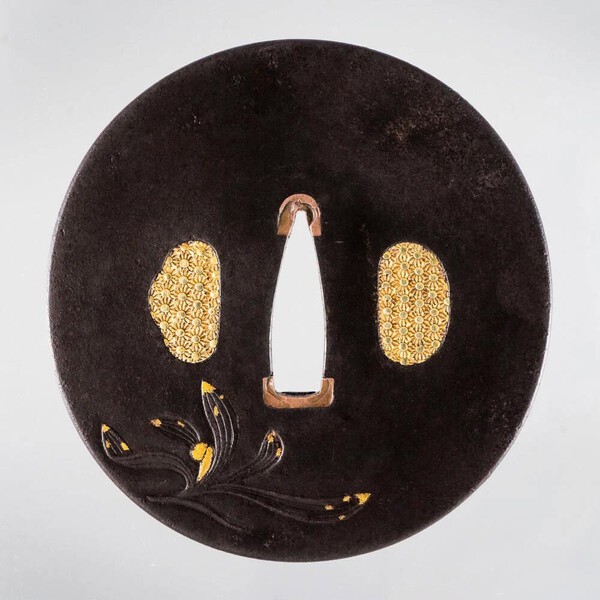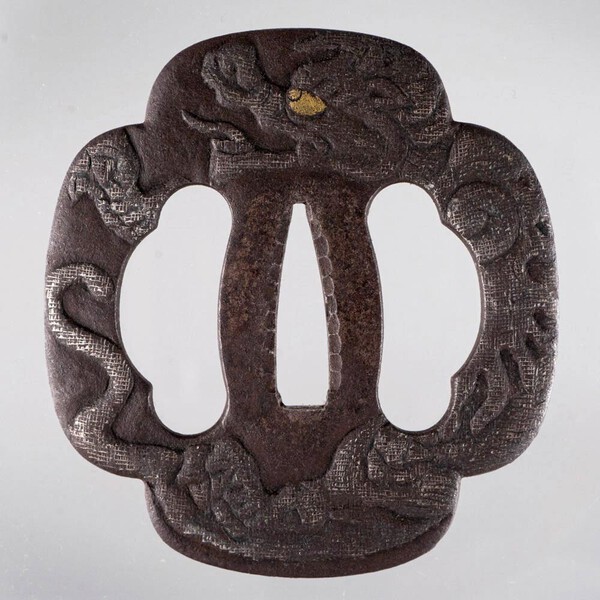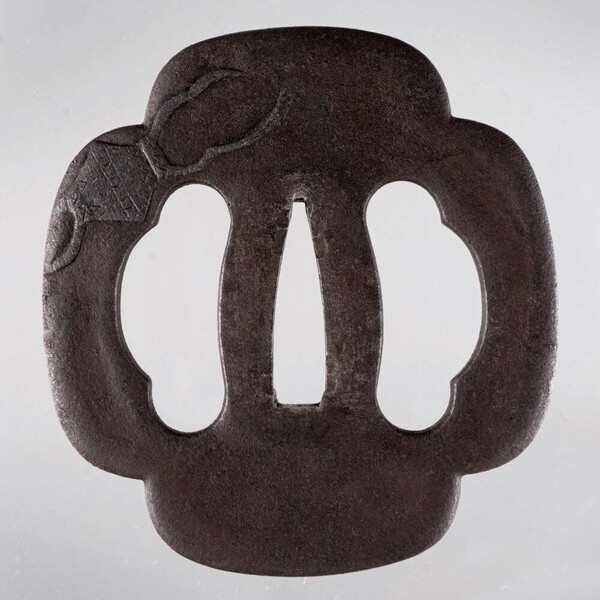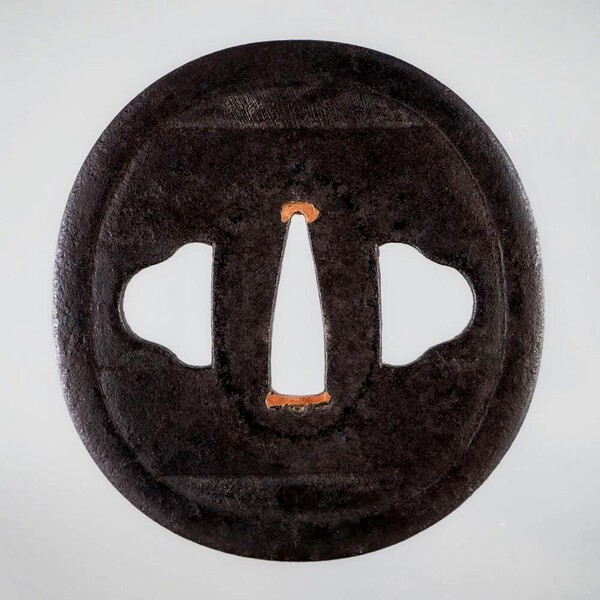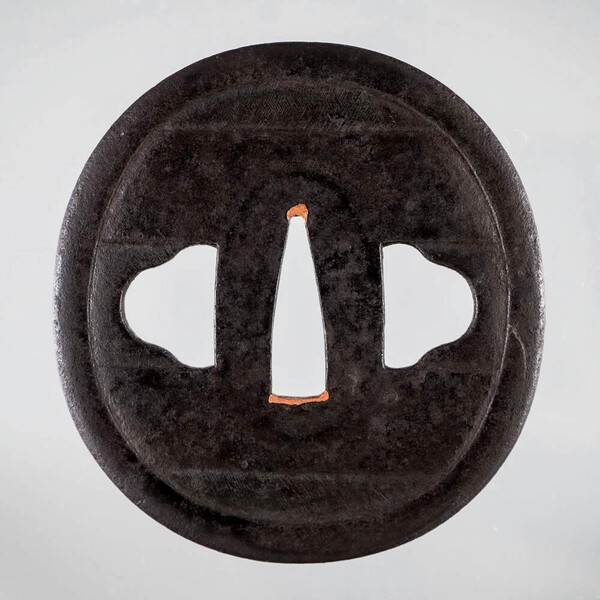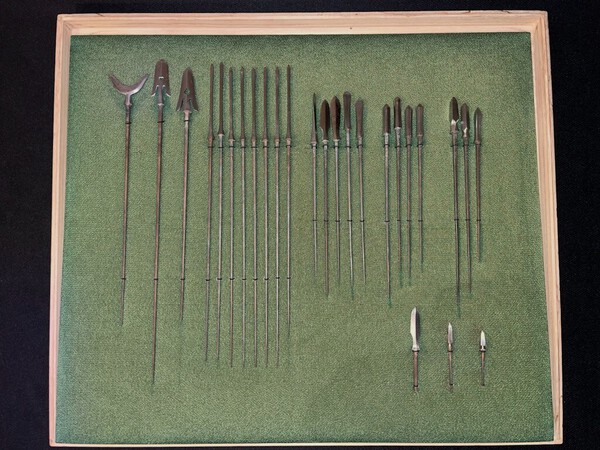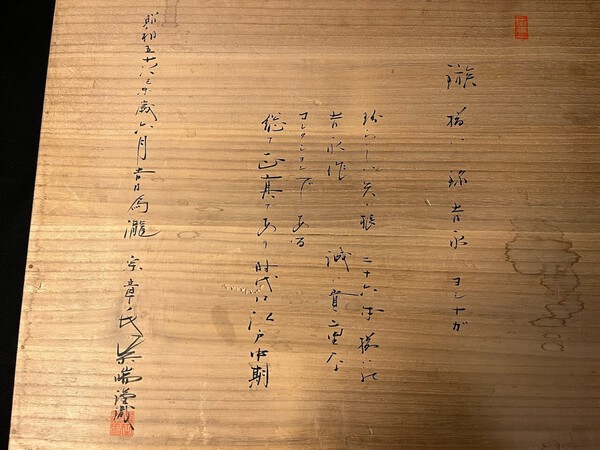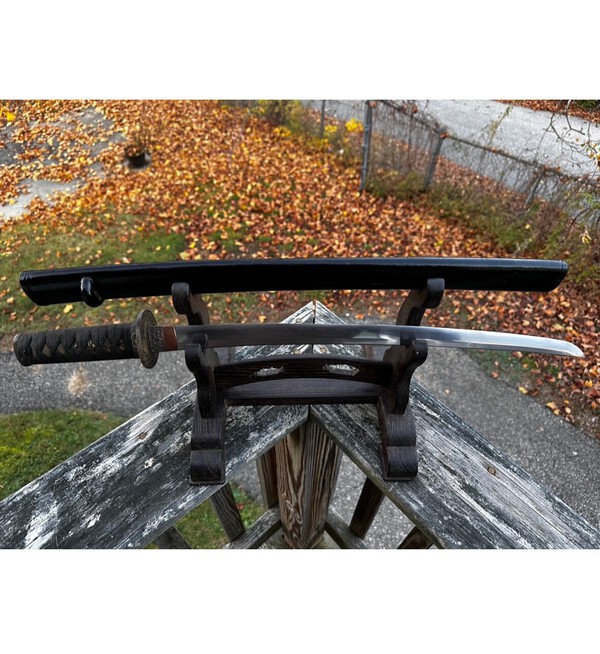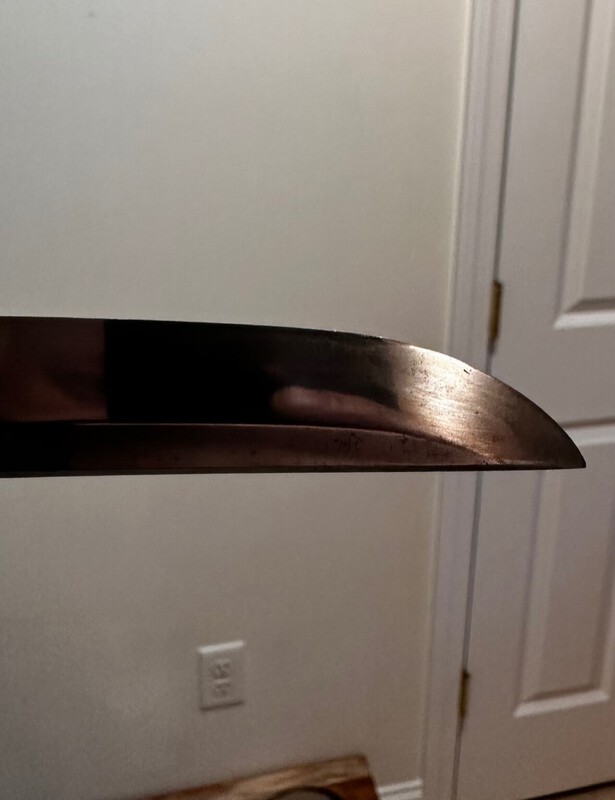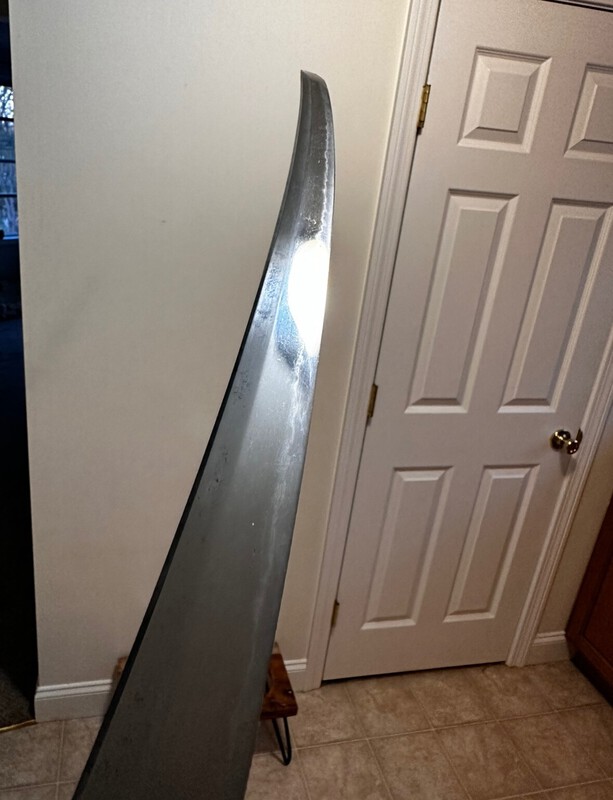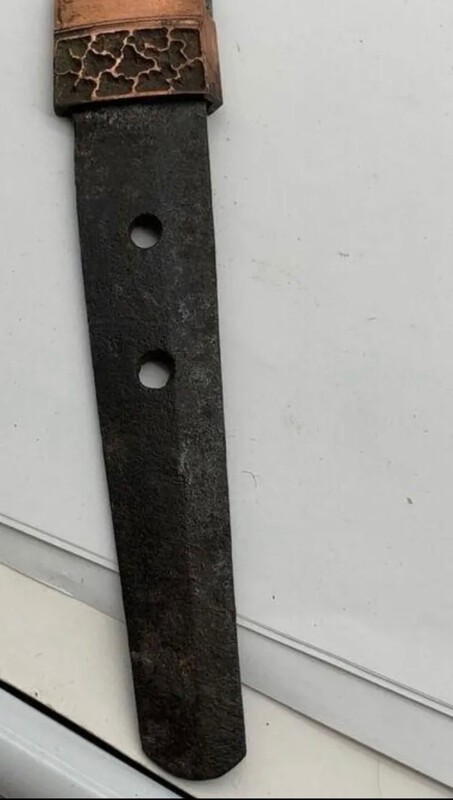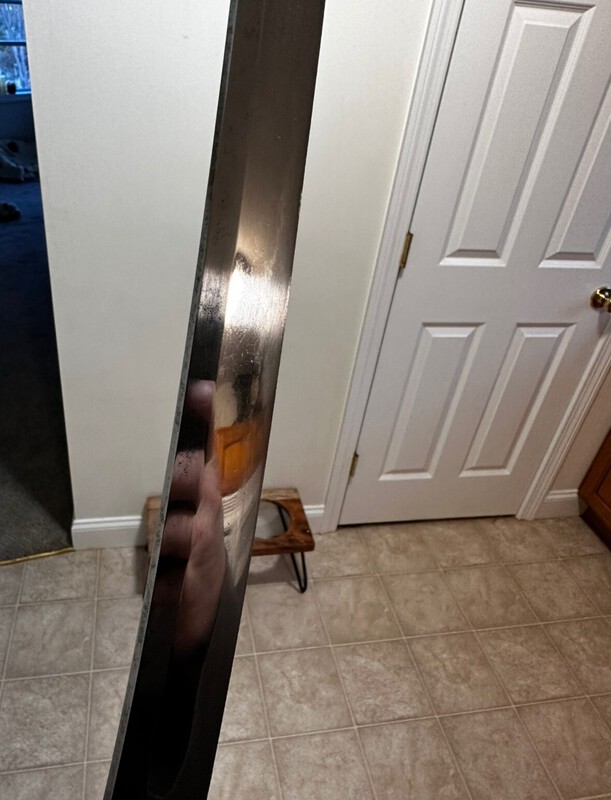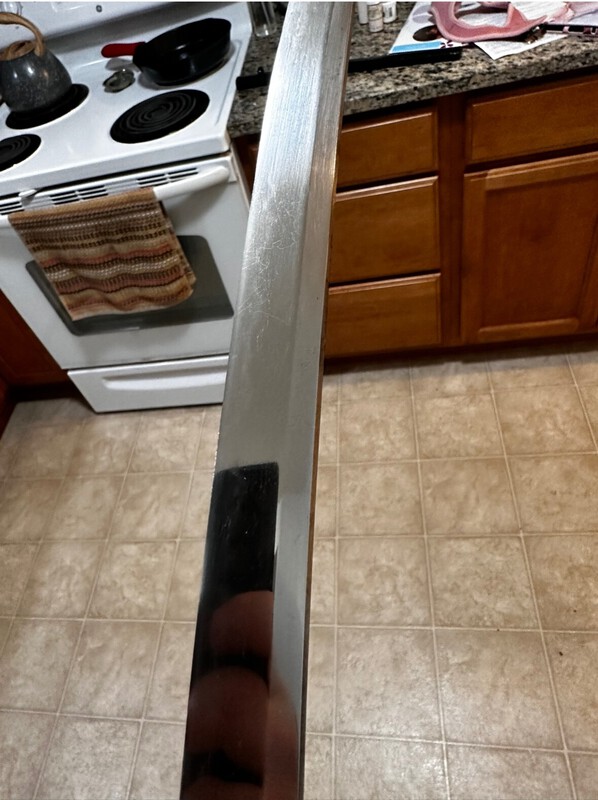Search the Community
Showing results for tags 'for sale'.
-
Mumei Blade Length : 70.0 cm Curvature : 2.0 cm Width at the Base : 31.0 mm Thickness at the Base : 7.6 mm Width at the Tip : 20.8 mm Thickness at the Tip : 4.9 mm Overall Length with Mountings : 97.4 cm - Price : $2700, negotiable. Want more details ? Send me a message. More pictures and video available on website.
-
Certificate : Hozon Token Mumei Edo Period Blade Length : 73.3 cm Blade Width at Base : 2.8 cm Blade Width at Tip : 2.0 cm Blade Thickness at Base : 0.7 cm Blade Thickness at Tip : 0.5 cm Blade Weight : 662g Full Length with Mountings : 110 cm - Price : $3500, negotiable. Want more details ? Send me a message. More pictures and video available on website.
-
Dear members, I am offering here a tsuba that is rarely seen in this combination. Mount Fuji with pine trees at the base ( not identical on both sides, but with variations) and the material is suaka, with plenty of leftover urushi. Beautiful color. Photos are made in the morning sun. Kokinko tsuba, suaka, Momoyama/ early Edo 66mm x 66mm. Relatively thick at 5.5mm, 123 gr. Price: 1800 € (excl. package and posting)
-
Dear all I would like to part with a nice early Tempo/Tembo/Tenpo tsuba. The kokuin stamp used to create the surface pattern has a kiri design. The quality of the iron is good and the lamination can be seen in the nagako and hitsu-ana. Finally, the tsuba has a Sukidashi-mimi. If you want to learn more about Tempo tsuba, there is a well written article about Tempo Tsuba by Malcolm E. Cox available in the Download Section. Dimensions: Tsuba: 8.09 cm x 8.16 cm x 0.3 cm Nakago-ana: 3.36 cm x 1.01 cm (widest point) Asking price: EUR 170.00 Shipping costs including tracking and insurance are: Germany EUR 6.99 EU EUR 16.49 UK EUR 26.99 Worldwide EUR 47.99 Best Chris
-
This tsuba has somehow ended up in my small and somewhat scattered collection from a distant past (25 years ago??) while I was living in Singapore and before I started collecting early sukashi tsuba at the beginning of this year. I just had David help out with the mei translation. Haynes H05405.0. Based on death before 1781 (An Ei), this tsubako appears to be a contemporary of the 7th (Shigehide) and 8th (Yoshihisa) generation of the Umetada Kyoto School. The writing on the white stickies are from the previous owner (there is another one on underside of lid). There is a carved and overlaid scene of two figures at 4:00 with landscape elements beneath clouds on omote. The tree and rocks wrap around to the ura. There are two kogai hitsu-ana of differing sizes. 74 mm (perfectly round), 4.7 mm, 4.0 at mimi. Comes in newish paulownia box. $350 (or best offer)
-
Type: Katana Ubu, Suriage or O-Suriage : Ubu Mei : (Mumei, Signature) : Mumei Papered or not and by whom? : NBTHK Hozon Era/Age : Shinshinto Shirasaya, Koshirae or Bare Blade? : Shirasaya with Sayagaki by Bizan Nagasa/Blade Length : 29.3 inches Hamon Type : Suguha Flaws : Some surface corrosion as seen in the photos Sword Location : Tampa, FL Will ship to : CONUS Payment Methods Accepted : PayPal and Venmo Price and Currency : $2,300 USD Other Info and Full Description : oversized large Katana in Shirasaya with Sayagaki, with NBTHk Hozon paper, Mumei unsigned, attributed to: 新々刀 Shinshinto (period) 阿州祐芳 Ashu Sukeyoshi as we all know, the general size and shape of Nihonto blades changes over the history, which reflects how they were intended to be used during that prticular period of time. during Edo period, with the society gradually returned back to peace and the establishment of new law and regulation, the average size of Katana became short and small comparing to their predecessors. However, this situation changed during the turbulent 幕末Bakumatsu period (the last stage of Edo period) when Katana were once again expected to be used on the cruel battlefront. With the introduction of advanced western firearms, those which used to take the dominant rule on the battlefield, Yumi (bow) and Yari (spears), were replaced by firearms and fell into disuse. The Katana became the only primary melee weapon, and the size of blade once again increased due to this reason. ——This particular blade by 阿州祐芳Ashu Sukeyoshi is a perfect sample of such Katana. 祐芳Sukeyoshi, also signed as 阿州吉川六郎源祐芳 Ashu Kikkawa Rokuro Minamoto Sukeyoshi, is a well appreciated Shinshinto period smith who mainly actived during the 幕末Bakumatsu period. Despite Sukeyoshi was born in the country of 阿波Awa (阿波国, today's Tokushima prefectured), it was told that he is the decendent of the 吉川Kikkawa family of the 毛利Mori clan that was originated in the country of 周防Suo (周防国, today's Yamaguchi prefecture). He studied under 横山祐永Yokoyama Sukenaga, the Edo period descendent of the famous 備前長船Bozen Osafune school, and later worked under the 蜂須賀Hachisuka clan of the 徳島藩Tokushima-han domain. Sukeyoshi's work is known for being favored by 近藤勇Kondo Isami, the leader of the famous 幕府Bakufu commissioned elite swordman group 新撰組Shinsen-gumi. As shown in the photos, like many other of his works, this sword is a typical Bakumatsu period "oversized" Katana with an obviously larger size in all aspects: thicker, longer, and wider, with a Moto-gasane of ~8mm and Saki-gasane of ~6mm —— it's a hefty monster in hand. The Shirasaya is very decently made by great quality wave-patterned 朴木Hou-no-ki wood, that's also large and thick as the size of the blade. It has 鞘書きSayagaki written, which reads as: 阿州吉川六郎源祐芳作 made by Ashu Kikkawa Rokuro Minamoto Sukeyoshi 新撰組局長近藤勇愛刀之一口 a blade favored by Kondo Isami, the leader of Shinsen-gumi 但本作生茎無銘也 but this piece is Ubu Nakago, Mumei unsigned 長ニ尺四寸七分 Nagasa 2 Shaku 4 Sun 7 Bu 令和五歳文月吉祥日 an auspicious day of July, 5th year of Reiwa 備山誌之 (花押) recorded by Bizan
-
1) Tsuba - Akasaka School Japan, Original https://www.ebay.de/itm/176263757878 Antik. Edo. Original aus Japan. School: probably early Akasaka 3rd Gen. Age: Edo Period / Region: Tokio Dimension: Size 66,8 mm x 70,4 mm x 6,2 mm (6,2/6,6), 65,9 g 2) Tsuba - Japan, Original https://www.ebay.de/itm/176263758854 Antik. Edo. Original aus Japan. School: reminds me of Tochihata. Age: pre-Edo Period Dimension: Size 62,3 mm x 63,0 mm x 5,1 mm (5,0), 55,1 g 3) Tsuba - Karigane - wild geese, Akasaka motive Japan, Original https://www.ebay.de/itm/176263759358 The Tsuba is made in the "Sukashi" technique, potentially made with a chisel and filing during Edo Period. The motive represents Karigane (Geese) in Flight, which is a typical Akasaka Motive. The patination and color of steel is typical for these authentic historic pieces. School: probably later Akasaka Age: Edo Period / Region: Tokio Dimension: Size 66,8 mm x 70 mm x 6,0 mm (6,3), 87 g
-
This Wakizashi is signed by Omi no Kami Fujiwara Tsuguhiro, a skilled student of the third-generation Yasutsugu from Echizen. Mei : Omi no Kami Fujiwara Tsuguhiro Echizen Ju Period : Early Edo Blade Length: 53.2 cm Base Width (Motohaba): 2.8 cm Tip Width (Sakihaba): 1.9 cm Base Thickness (Motokasane): 0.7 cm Tip Thickness (Sakikasane): 0.5 cm Blade Weight: 455 g Hamon: Notare Price for Forum : ̶$3̶5̶0̶0̶ -> $3200 + $50 Shipping (with insurance from Japan) -> More pictures and video available (please send a message).
-
Mumei Attribued to Fuyuhiro Period : Late Muromachi Blade Length : 36,2cm Motohaba : 2,9cm Sakihaba : 2,5cm Motokasane : 0,7cm Sakikasane : 0,5cm Weight : 339g Price for group : ̶2̶5̶0̶0̶ $2300 + $50 shipping (with Insurance, from Japan) More and pictures and video available. Don't hesitate to send a message. Fuyuhiro's lineage is rooted in the Muromachi period, with the swordsmith's family moving to Wakasa province, known today as Wakayama. Fuyuhiro was the son of Soshu Hirotsugu, and his craft was held in high regard, forging blades in both Sagami and Wakasa.
-
Raising $ for my Kanayama/Owari Fund. This is a love daisho with plum branch and blossom theme in copper, silver, gold, shakudo inlay/overlay. $650 including shipping in US (ask for quote for international). Links to similar examples with various attribution to Ko-Nara or Umetada. https://www.worthpoi...-guard-ume-tsuba-for https://www.ngv.vic....llection/work/54298/ Katana: 73.2, 68.6, 4.5, 4.0 mimi Wakizashi: 69, 62.8, 4.0, 3.2 mimi
-
Original WW2 Army Katana GENERAL's TASSEL For Sale. $2400 or best offer. Here is the link to additional photos: https://stcroixblade...t-ww2-samurai-ija-2/ --Matthew Brice St. Croix Blades
-
https://www.ebay.com/itm/355506420160 I'm currently selling this Gendaito I bought a while ago. Price is negotiable. Gendaito Katana, Signed Yoshichika (may 1944). This is a Gendaito made in May 1944 by Yoshichika: the fittings are combination of traditional koshirae and Gunto koshirae, this is an arsenal sword. The tsukaito is lacquered silk and fits loosely, The tsuka has some rattle Yoshichika was known for using unorthodox materials for his blades, this one appears to be made from a modern steel as opposed to Tamehagane, which isn't unusual for swords of this era, but is definitely made through traditional methods. The hamon is VERY light and difficult to see unless under very specific lighting due to the polish variation, but it is definitely there with a suguha hamon. The koshirae are an interesting mix of Traditional Edo Era style fittings with elements of Imperial Japanese Gunto fittings: Primarily with Gunto style Menuki and Kashira. Additionally, and interestingly, the Menkui are placed in the tachi-style top right bottom left configuration, seen often on arsenal swords and gunto. Additionally, the Naval Knot on the tsuka is the right hand side. All of this points to the sword being worn tachi/gunto style with the blade facing down, yet the sword is fit with a standard Uchigatana style saya to be worn with an Obi, facing up. The saya is a standard black lacquer with Buffalo Horn fittings on the bottom and top for stability. No major cracks or forging flaws. The blade is healthy and heavy without much Sori. STAND NOT INCLUDED Please forward me any questions Nagasa 27 inches Tsuka 10 inches Will be shipped with a free sword bag and the original registration license. The blade will be be oiled before shipment.
-
https://www.ebay.com...icSeller=1&_saslop=1 Any questions, let me know. --Matt St. Croix Blades 715-557-1688 phone/text
-
Raising $ for my Kanayama/Owari fund. This brass Shonai kaku-maru-gata tsuba with some elements of copper-colored metal overlay is similar to several currently on eBay except that a moon replaces the geese and there are stars. Nanako appears to be worn on the front, well preserved on the back. $900 including shipping in the US (request quote for international shipping). 69.3, 63.5, 5.1 with fukurin Similar on eBay: https://www.ebay.com/itm/285565279191 https://www.ebay.com/itm/144831048303
-
Raising $ for my Kanayama/Owari Fund. Offered are a few nice iron plates with high relief bird motifs and silver and gold colored mixed metal inlays/overlays. Excellent condition. $350 or best offer each including shipping in US (request quote for international shipping). Tsuba #1 Crane over waves. Very fine detail of feathers over top of wings. 72.7, 69.2, 4.7, 3.3 mimi Tsuba #2 Millet amidst reeds or cat tails. Rendering of millet was apparently challenging for artisans of this period. 71.6, 67.4, 4.4, Fukurin rim cover.
-
Komihara Katana for Sale, a beautiful koto sword. Specifications: Sori (Curvature): 0.8 cm Hamon (Temper Line): Suguha, characteristic of Ko-Mihara school Blade Length: 60.8 cm Period : Nanbokucho (650 years ago) Province : Bingo 備後 Certificate : NBTHK Tokubetsu Hozon Token Koshirae SOLD You can see more pictures or videos on my website. Don't hesitate to send me a message if any question
-
Type: Wakizashi Nakago: ubu Mei : Sagami no Kami Hiroshige Papered by the NBTHK to Tokubetsu Hozon Era/Age: Kanbun (1661-1673) Shirasaya, Koshirae or Bare Blade? : Shirasaya Nagasa/Blade Length : Sori : 1.5 cm Hamon Type : notareba Jihada : itame Other Hataraki Visible : Ashi, Yakumo-midare jigane, Ko-nie Flaws : none Sword Location : CO USA Will ship to : most countries Payment Methods Accepted : Zelle, Cashapp, Venmo, Wise, Paypal Price and Currency : $4500 USD More Info: This is a very fine and healthy Soshu blade crafted and signed by the second generation Sagami no Kami Fujiwara Hiroshige (相模守藤原広重), this blade comes from the Kanbun era(1661-1673) in the early Edo Period. The Bushu Shitahara school, where Hiroshige was trained, is in what's now Hachioji city, Tokyo. Founded by Yamamoto Norishige, the school flourished from the late Muromachi to the late Edo period (late 16th to late 19th century). Terushige, a notable pupil of Norishige, taught the first-gen Hiroshige, who then established his lineage in swordsmithing. The second-gen Hiroshige, originally named Yamamoto Fujiemon, was his eldest son. A famous example of this school is the smith Musashitaro Yasukuni. It is an ubu, signed blade, featuring only the original mekugi-ana. It is in good polish, allowing for full view of the blade's craftsmanship. The blade’s activity is extremely striking. The hamon is notareba with very visible ashi in the yakiba. The boshi is very visible as komaru within the surface of the O-kissaki. The itame-hada is well defined and jigane is made up of “Yakumo-Midare” which is the specialty of this group of smiths. The color is a beautiful deep blue when viewing it under direct light. Nagasa: 51.1 cm Sori: 1.5 cm Moto-haba: 3.02 cm Saki-haba: 2.09 cm Kasane: 0.7 cm Accompanying the blade is a well made copper niju-habaki, a well fitting and finely shaped shirasaya, a buffalo horn mekugi, and a velvet colored silk storage bag, and lastly a full oshigata on traditional rice paper.
-
A rare and historic sword owned by Gensui Prince Aritomo Yamagata, who led the new modernized Imperial Japanese Army in their defeat of the Satsuma Rebellion--ending the era of the Samurai. An historic Presentation sword to Japanese Field Marshall and twice-elected Prime Minister Aritomo Yamagata. Yamagata led the new modern Japanese Army in their defeat of the Satsuma Rebellion led by samurai Saigo Takamori of Satsuma in 1877 (as detailed in the movie The Last Samurai). A sword of special interest to historians and to those that collect items from historical figures featured in famed Hollywood movies. This sword is a U.S. model 1852 Navy Sword modified for Presentation to Field Marshall Yamagata. This sword is published on pages 246 & 247 of Jim Dawson's Swords of Imperial Japan 1868-1945--a Cyclopedia. The sword is etched on the blade 'T.A. Yamagata'. A quick historical search of Aritomo Yamagata shows that he was born Tatsunosuke Yamagata. He changed his name to Aritomo Yamagata at the start of the Meiji Restoration. Thus the 'T. (Tatsunosuke) A. (Aritomo) Yamagata' inscription. Yamagata held innumerous positions of the highest levels--both in the Japanese Military and in the Japanese Government. Among his many positions: --Chief of the General Staff of the Imperial Japanese Army for three different terms. 1878-1882, 1884-1885, and 1904-1905. --Awarded the level of Field Marshall in 1898, also referred to as Gensui or Gensui Prince (5-Star General). --Served two terms as the Prime Minister of Empire of Japan. 1889-1891, and 1898-1900. --President of the Japanese Privy Council for three terms. 1893, 1905-1909, and 1909-1922. --Acting War Minister and Commanding General during the First Sino-Japanese War. --Commanding General of the Japanese First Army, Russo-Japanese War. Also, among his most notable achievements: --Yamagata succeeded in urging Emperor Meiji to write the Imperial Rescript to Soldiers and Sailors in 1882. This document was the moral code of the Imperial Japanese Army & Navy until Japan's defeat in World War 2. --As noted above, Yamagata led the new modern Japanese Army in their defeat of the Satsuma Rebellion led by samurai Saigo Takamori of Satsuma (as detailed in the movie The Last Samurai). CONDITION: This historic sword is in exceptional condition. Some of the original gold gilt is still present on the blade. There is no scabbard as the original leather scabbard with brass fittings (assuming it had one) did not survive the last 146 years. $35,000 obo (If paying via Paypal or credit card, add 4% fee) --Matthew Brice www.StCroixBlades.com
-
New sword listings from St. Croix Blades: https://stcroixblade...hop/Japanese-swords/
-
Hello everyone, I'm looking to part ways with some very nice pieces from my Tsuba collection. While some have already found new homes, I'd like to share a few more interesting pieces with you. So, treat yourselves, perhaps with an early season gift. More images are available upon request. If you have any questions or would like to make offers, please feel free to PM me. A donation to the forum will be made upon sale. Thank you for your interest. Hannes 1. Higo, Den Kamiyoshi, Kagecho Sukashi (Butterflies), Late Edo Period, 75 x 80 x 3 mm, EUR 680 plus shipping The Tsuba is a beautiful piece with a monumental expression in the tradition of Fukanobu Kamiyoshi (1786 – 1851). The design is an adaptation of the Ko Shoami Tsuba that was mounted on the famous Kazen Koshirae. As is common with this design, the seppadai is enlarged and bigger than the tsuka diameter, showcasing the eyes of the butterflies when mounted. The placement of the Tagane is also true to form, although in my opinion, not as precisely positioned as I would expect from Fukanobu's work. Therefore, it is priced as student (Den) work. A similar Design can be found in Works of Hayashi & Kamiyoshi, Nr. 229 on page 315. Polished iron, dark patina, and in great condition! The Tsuba comes with a box. 2. Higo, Den Kamiyoshi, Distand Pine-Tree, Late Edo Period, 80 x 80 x 4.5 mm, EUR 480 plus shipping The design is an abstract interpretation of a distant Pine-Tree, where the rim is artistically included as a part of the design. It is a beautiful, organic, irregular shape. This design is also well known throughout the Hayashi Schools. A similar Design can be found in the Higo Kinko Taikan, Nr. 356 on page 357. Very good, dense, polished iron, perfect black patina with a great wet look. Flawless condition! Tsuba without a box. 3. Higo, Nishigaki, Sakura Blossom, Edo Period, NBTHK Hozon, 69 x 73 x 4-3 mm, EUR 1.450 plus shipping An exquisite Sukashi Tsuba - in my opinion a Nishigaki Kanshiro or Kampei Tsuba. This remarkable work showcases a truly elegant motif of falling Sakura blossom. It is a very elegant and outstanding piece, that is hard to part with. Layer construction is visible in the sukashi. It has a nice black/brown/violet patina. The overall condition is great. The Tsuba comes with a quality box and NBTHK Hozon papers (Higo). A comparable work can be found in Works of Kanshiro Nishigaki, Nr. 133 on page 156. 6. Inshu No Ju Suruga, Ornamental Plants, Edo Period, 75 x 78 x 3.6 mm, EUR 580 plus shipping It is a typical work of the Suruga School. From 1632 onwards, the Suruga masters signed as Inshu no ju Suruga as seen on this example. Also, the distinct sekigane are typical. It features ume-gane in gold, usually made with gilded copper; the deep engraving suggests the use of a heavy gold sheet or solid gold (but you will never know without removing them, which would be a shame). The condition is great, it features a dark, black patina; the nunome zogan is fully intact and enriches the design as intended centuries ago. The Tsuba comes with a box. Very similar examples can be found in the Ashmolean Museum (http://jameelcentre.ashmolean.org/). 7. Higo, Jingo, Rain Dragon, Edo Period, NBTHK Hozon, EUR 1.100 plus shipping This work is a representation of the later Jingo schools. It is adorned with a finely carved dragon in striking, fully intact silver and gold nunome. On the reverse side, the Buddhist motif vajra is featured, also highly detailed in silver inlay. This piece showcases the artistry in its finely formed iron plate in the elegant mokko gata shape, displaying a chocolate brown patina with fully intact inlays. It is a wonderful work! I bought this some years back from Fred Weissberg (https://nihonto.com/). The Tsuba comes with a box and NBTHK Hozon papers (Kodai Higo). 8. Higo, Jingo, Futatsu Biki or Hikiryo Mon (Two Lines), Edo Period, 72 x 76 x 4.5-2 mm, EUR 340 plus shipping Featuring a very elegant design of Futatsu Biki or Hikiryo Mon (Two Lines), a design native to many Higo schools. This particular example belongs to the late Jingo school. The Tsuba shows an exquisite dark, black patina, with remnants of silver inlay still visible in some spots. Tsuba without a box. A comparable Tsuba can be found in Works of Hirata & Shimizu, Nr. 55 and 88 on page 202 and 233.
-
1 fine Japanese display collection of 26 Edo period (1603-1867 A.D.) Samurai arrow points. These 26 yanone are of various shapes. The back of this large display describes these yanone. The translation is as follows: This is a very rare set of 26 pieces made by Yoshinaga (of the Sanjo region of Kyoto). Truly valuable collection Everything is authentic and dates back to the mid-Edo period (written on an) Auspicious day in June 1981 Muneaki Taki (wrote this) A museum quality display for any fine den or boardroom. $5200 More photos available here: https://stcroixblade...-yanone-yajiri-rare/ --Matthew Brice St. Croix Blades
-
Christmas must be in the air to offer for sale this KAI GUNTO at such a crazy price. A nice blade made by HATTORI MASAHIRO ( I don't know if he was related to HATTORI HANZO, who made the Kill Bill sword, one can only speculate!). The mei from Slough and the sword attached, this is NOT made of rust proof stainless steel. Koshirae is premium ray skin, plus working locking mechanism, and Navy premium sun-ray seppas. The sword did not come with two hangers, as is sometimes the case, but I will throw in a second one if that bothers anyone. Kai Gunto, are not that common, as many went to the bottom of the sea during the war. I will post this express, with tracking included for AUD1400, thats just over a grand US. This is definitely better and probably cheaper than a martial arts sword used for cutting etc, it is genuine WW2 Japanese, and will hold its value.
-
Type (Tachi, Katana, Wakizashi, Tanto, Naginata, Other) : Wakizashi Ubu, Suriage or O-Suriage : unknown Mei : (Mumei, Signature) : Mumei Papered or not and by whom? : not papered Era/Age : Edo Shirasaya, Koshirae or Bare Blade? : Koshirae Nagasa/Blade Length : 46cm Sori : 1.5cm, Torii Hamon Type : Midare Jihada : Itame Other Hataraki Visible : unknown Flaws : no fatal flaws observed, see pictures Sword Location : New Hampshire, USA Will ship to : USA Payment Methods Accepted : Venmo preferred, Zelle, PayPal (least preferred) Price and Currency : SOLD usd Other Info and Full Description : more pictures upon request
-
Dear collectors and readers interested in Tsuba, I am parting with a significat part of my collection so please feel welcome to buy or make an offer on the items shown. T001 - Tsuba: Leaves Motive 120 € T004 - Shingen Tsuba 240 € T005 - Akaska 250 € T006 - Tatsunao - signed 350 € T008 - Shoami 480 € T009 - Owari 230 € T010 - Akasaka 240 € T024 - Yamashiro Kaneie - signed 280 € T025 - Saotome | Būshū itō School 600 € T026 - Higo 340 € T029 - Ni-Tomoe Tsuba / Kyoto?`350 € T030 - Akasaka, NBTHK - Hozon Kanteisho 750 € T032 - Akasaka or Owari 400 € T035 - Ko-Kinko 850 € T036 - Bushu-ju Masanaga - signed 300 € T039 - Akasaka, NBTHK - Hozon Kanteisho 850 € T041 - Akasaka Tadafusa, NBTHK - Tokubetsu Kicho Hozon Kanteisho: Akasaka 900 € T040 - Shoami School - Signed 正阿弥 NBTHK - Hozon Kanteisho 700 € T048 - Akao School 420 € T051 - Akasaka or Kamiyoshi 430 € T052 - Shigenobu Shoami 100 € T056 - Shigenobu Shoami 100 € T064 - Shigenobu Shoami 80 € T062 - Shigenobu Shoami 80 € T057 - Ko-Akaska 280 € T065 - modern Tsuba for Iaido (very well made) 200€ T066 - Owari Design - I think its modern 220 € T067 - Higo 300 € T068 - Tsuba Mumei 250 € T078 - Akasaka 300 € To reduce traffic on the board - more picture only on request by pm. Shipping from France or Germany at best rates - typically next day. Best wishes, Tobi
-
Just a quick community notice about the Art of the Samurai Bonhams Online Auction. Here is a link to register: Bonhams : Arts of the Samurai. I have already registered for this auction. Highlight of the auction include A Kotō Tachi made circa Kamakura period (1185-1333), 13th century attributed to Shinsoku with Shinsoku orikaeshi mei. The tachi is honzukuri, iorimune, ko-gissaki configuration with a strong koshizori curvature, forged in mokume hada with a ko-chōji tempered edge and midarekomi bōshi, ō-suriage tang with kiri file marks and four holes, orikaeshi mei Shinsoku, with a one-piece habaki, 26 1/2in (67.2cm.) long, in a wood shirasaya storage scabbard inscribed Matsudaira-ke zō (Matsudaira household collection). Here are some interesting provenance notes from the Bonhams website. Provenance Sold Christie's, New York, September 15, 2003, lot 384 Walter A. Compton Collection, sold Christie's, New York, Japanese Swords and Sword Fittings from the Collection of Walter A. Compton, Part II, October 22, 1992, lot 207 Tokugawa Ienari (1787-1837, purported) Matsudaira family (purported) Iwakura Tomomi (1825-1883, purported) The shirasaya bears an inscription claiming that in the early days of the Kamakura shogunate, in the second month of 1252, Prince Munetaka, son of the Emperor, went from Kyoto to Kamakura to inaugurate the government and was attended by Kiyohara Noritaka Sagami-no-suke Mikawa-no-kami, of the rank of Daiki Shōgo-i, to whom he gave this sword. With an origami (photocopy only) bearing the seal of the eleventh Shogun Tokugawa Ienari stating that the blade had been given to the Matsudaira family, and an origami (photocopy only), dated Meiji 9 (1876) and signed by the Iwakura household, stating that the blade had been given (to Prince Iwakura Tomomi) by the Matsudaira. Feel free to discuss it politely. Thank you.

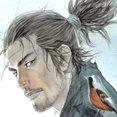
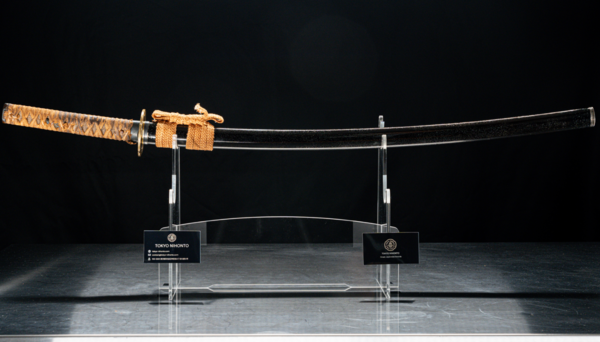






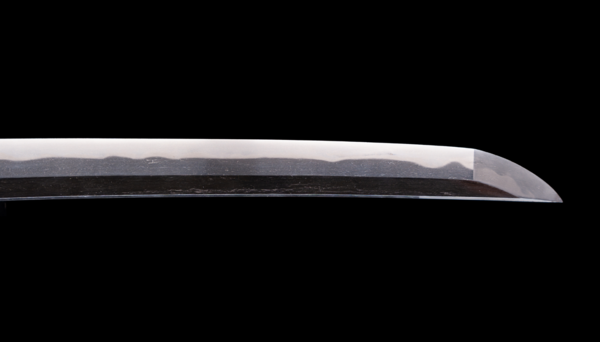
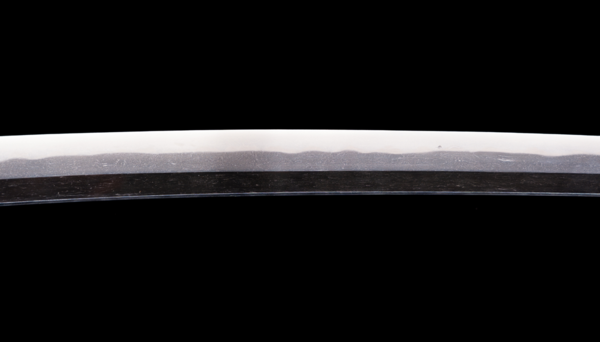
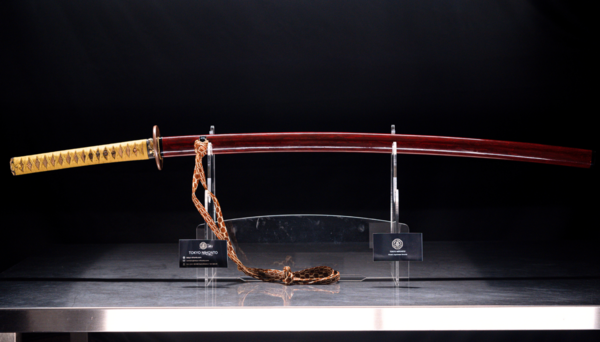

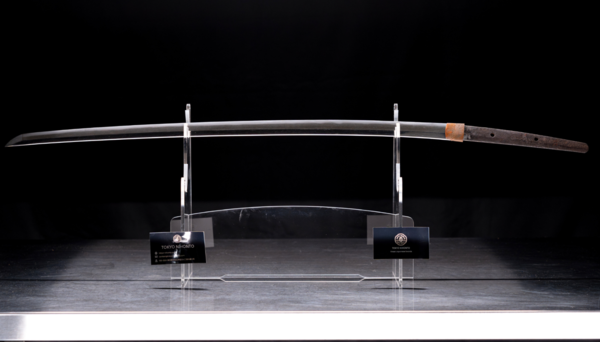
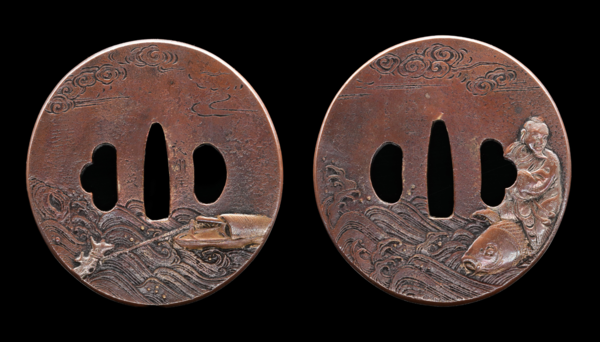






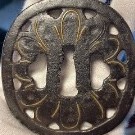














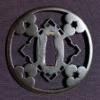









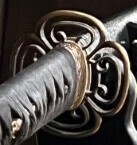

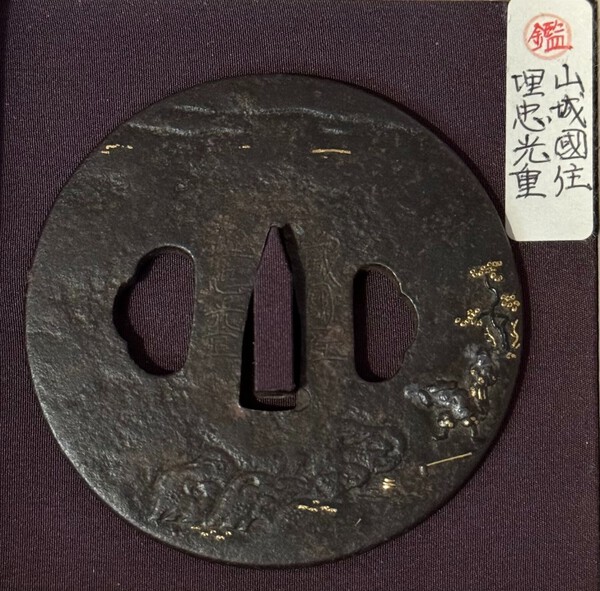







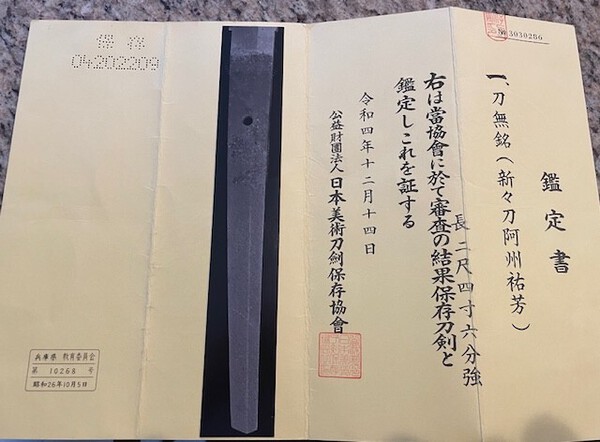
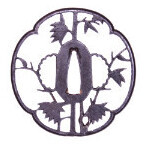


.thumb.png.fb0770e65b2ba55fc58e39506e218855.png)
.thumb.png.340a4df01d43b5dcabbae5b09bfd9ae2.png)
.thumb.png.c8deefb6441d66fa028e7934891d5af5.png)
.thumb.jpg.abdc2ac3afc3bb82f2251bf5c35feedf.jpg)
(1).thumb.png.9762f1a5e48f440987302692c9d53dc0.png)


.thumb.jpg.ca912032a9801178b2837ff29b90fbe3.jpg)
.thumb.png.2e9bed00ad6973a8cc549d5d5fa75d24.png)
.thumb.png.75d13bf0d5e8a9d74d336e9593617631.png)
.thumb.png.436b53ef33a4efea123a47f0e0977d0b.png)
(1).thumb.png.e4bd6b58c1c2047fbf836d4600229e3a.png)




